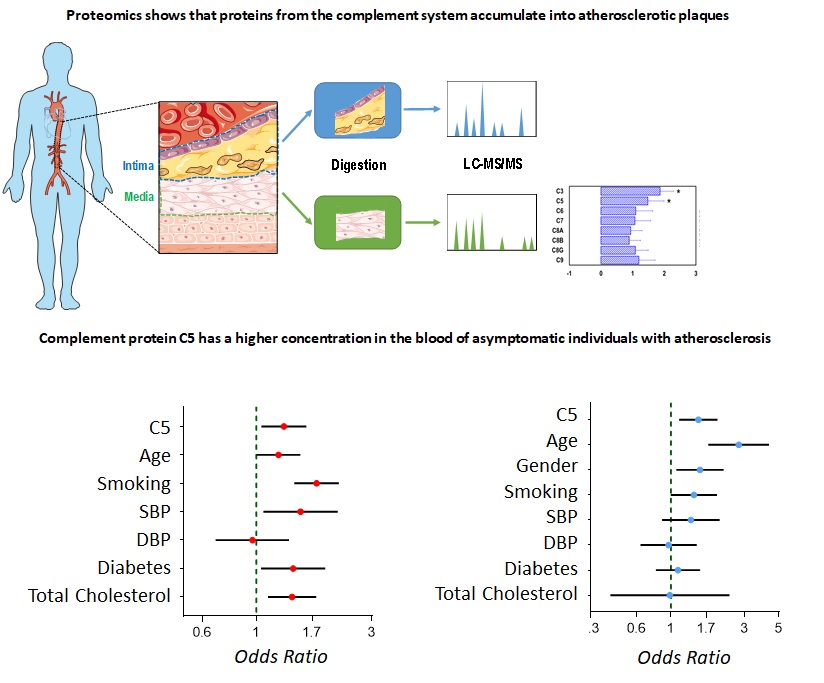JACC: Spanish scientists identify a biomarker that detects atherosclerosis before the appearance of symptoms
The study, published today in JACC, shows that activation of the complement system is one of the most characteristic molecular changes taking place in the early stages of the development of atherosclerotic plaques
Scientists at the CIBER de Enfermedades Cardiovasculares (CNIC) and the Investigación Sanitaria-Fundación Jiménez Díaz (IIS-FJD) in Madrid have demonstrated that a proteins present in early atheroma plaques—accumulations of cholesterol in the wall of arteries—could be used as a biomarker to detect atherosclerosis in the subclinical phase, before the appearance of symptoms.
The study, published today in The Journal of American College of Cardiology (JACC), concludes that activation of the complement system is one of the most characteristic molecular changes taking place in the early development of atherosclerotic plaques. The study shows that plasma levels of the complement system protein C5 could be used to identify individuals with subclinical atherosclerosis in a noninvasive way and at minimal cost. “Early identification of the disease would help to select individuals who would benefit from more costly noninvasive imaging analysis to get a more precise estimate of their cardiovascular risk,” explained Dr Jesús Vázquez, head of the Cardiovascular Proteomics Laboratory at the CNIC and one of the coordinators of the study.
Cardiovascular disease is one of the biggest public health problems in the world. Spanish national institute of statistics data show that in 2018 around 121,000 people died from cardiovascular disease in Spain. Cardiovascular disease can trigger a heart attack or stroke, making it one of the leading causes of death in the world. “These events are due to the formation of atheroma plaques in the arteries, a process known as atherosclerosis,” explained study co-coordinator Dr José Luis Martín-Ventura of the IIS-FJD. “Atheroma plaques can rupture, releasing their contents and triggering the blood clotting cascade and the formation of clots that block blood flow.”
Atherosclerosis before these events is usually asymptomatic, and its underlying causes are poorly understood. “Current treatments are based on controlling major cardiovascular risk factors: high blood cholesterol, elevated blood glucose, hypertension, smoking, physical inactivity, and so on. However, these values of these parameters is limited value because even people who don’t have these risk factors have cardiovascular events,” explained Dr Martín-Ventura.
PESA CNIC-SANTANDER
The new study forms part of the PESA CNIC-SANTANDER project (Progression and Early detection of Subclinical Atherosclerosis). This major project, a partnership between the CNIC and Santander Bank, studies the development of atherosclerotic plaques in 3 arterial territories: the carotid arteries, the abdominal aorta, and the iliofemoral arteries. PESA studies these arteries in a population of asymptomatic, healthy Santander Bank workers between the ages of 40 and 54 at the time of recruitment. PESA CNIC-SANTANDER is providing important information about the high prevalence of subclinical atherosclerosis in the general population and the need to detect it early.
On the new JACC study, the researchers studied the mechanisms underlying the early development of atheroma plaques, with the aim of identifying new diagnostic biomarkers.
The research team designed a detailed study of the molecular composition of plaques in their initial stages, using the latest technology for massive proteomics screening. The study showed that, in their earliest stages, atheroma plaques accumulate proteins of the complement system. Complement activation is a key component of the immune system, and could induce changes in inflammatory cells in the plaque, promoting its progression. “These results give us new clues about the mechanisms underlying atherosclerosis and suggest that the circulating levels of complement proteins might be used to detect the presence of atherosclerosis,” said Dr Vázquez.
The authors measured the levels of C5, an important complement protein, in blood samples of 360 participants in the PESA CNIC-SANTANDER project. This analysis showed that the blood concentration of C5 is higher in individuals with more than 2 atherosclerotic plaques. The findings were then validated in an independent study of 400 asymptomatic men and women.
The authors conclude that complement activation is a key molecular alteration in the first stages of the development of atherosclerotic plaques and that plasma C5 could be used to screen for individuals with subclinical atherosclerosis, thus helping to select those who would benefit from more costly imaging analysis to obtain a more precise picture of their cardiovascular risk.
Besides CIBERCV and CIBERER, the Community of Madrid (Complement II-CM, S2017 / BMD-3673) and Fundación Bancaria “la Caixa” (HR17-00247) have participated in the article.











